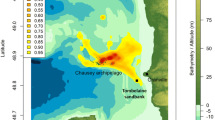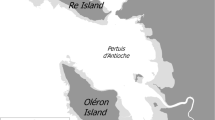Abstract
Location data of four White-tailed Sea Eagles (Haliaeetus albicilla) (WTSE) from four pairs equipped with GPS data loggers or automated GPS–GSM units and visual behaviour observations were used to record their home range size and territoriality. Between 18 and 571 positions were received from the satellite devices. Extensive excursions were identified by defining the distance to the activity centre and have been removed before home ranges were computed. Home range size varied considerably among the individuals tracked. Minimum convex polygons, with outliers removed, ranged between 2.25 and 19.16 km2 and 95 % kernel contours (calculated in Ranges 8) varied from 2.37 to 12.04 km2 in the Mecklenburg Lake District. Occurrence of territorial behaviour as identified by visual observations changed significantly throughout the year with a maximum in May and a minimum in December. An optimal habitat quality characterized by shallow and fish-rich freshwater lakes with undisturbed nesting areas in surrounding forests is a prerequisite for small home ranges and for the high abundance of breeding birds found within the Mecklenburg Lake district. The year-round territoriality is attributed to a sufficient food supply throughout the seasons, either by mild winters allowing access to fish and/or waterfowl on open waters or, in hard winters, to the availability of carcasses and remains of larger animals from hunting activities when frozen lakes restricte access to prey.
Zusammenfassung
Seeadler ( Haliaeetus abicilla ) verteidigen ihre Streifgebiete ganzjährig im Nordosten Deutschlands
Zur Erfassung der Streifgebietsgröße und Territorialität wurden Positionsdaten von vier Seeadlern (Haliaeetus albicilla) aus vier Paaren die mit GPS Datenspeichern oder automatischen GP-GSM Geräten ausgestattet waren, zusammen mit Verhaltensbeobachtungen genutzt. Die Satellitenempfänger zeichneten zwischen 18 und 571 Lokalisationen auf. Vor der Berechnung der Streifgebietsgrößen wurden extensive Exkursionen, die durch ihre Distanz zum Aktivitätszentrum identifiziert werden konnten, entfernt. Die Streifgebietsgröße variierte erheblich zwischen den untersuchten Vögeln. So rangierten Seeadlerstreifgebiete in der Mecklenburger Seenplatte bei den Minimum Konvex Polygonen zwischen 2.25 und 19.16 km² und bei den 95 % Kernel Analysen (berechnet in Ranges 8) zwischen 2.37 und 12.04 km². Das durch Sichtbeobachtungen ermittelte Territorialverhalten änderte sich im Jahresverlauf signifikant und zeigte ein Maximum im Mai und ein Minimum in Dezember. Die optimale Habitatqualität ist hier durch fischreiche Flachgewässer und ungestörte Brutbereiche in den die Seen umgebenden Wäldern charakterisiert und somit eine Voraussetzung für die kleinen Streifgebiete der Seeadler und die hohe Dichte an Brutpaaren innerhalb der Mecklenburger Seenplatte. Die Territorialität der Adler ist durch eine ganzjährige Nahrungsverfügbarkeit begründet, wenn aufgrund von milden Wintern Zugang zu Fischen und/oder Wasservögeln auf offenen Wasserflächen besteht. In strengen Wintern mit zugefrorenen Seen ist die Territorialität der Seeadler auch durch das Vorhandensein von Kadavern bzw. Aufbrüchen/Teilen von in der Jagd erlegten Tieren, wenn der Zugang zu anderer Beute eingeschränkt ist, begründet.



Similar content being viewed by others
References
Banzhaf W (1937) Der Seeadler. Dohrniana 16:2–41
BirdLife International (2008) Haliaeetus albicilla. In: IUCN 2009. IUCN Red List of Threatened Species. Version 2009.1. [Online] Available at www.iucnredlist.org
Brown L, Amadon D (1989) Eagles, hawks and falcons of the world. Wellfleet, New York, pp 291–296
Burt WH (1943) Territoriality and home range concepts as applied to mammals. J Mammal 24:346–352
Byholm P, Kekkonen M (2008) Food regulates reproduction differently in different habitats: experimental evidence in the goshawk. Ecology 89:1696–1702
Del Hoyo J, Elliott A Sargatal J (1994) Handbook of the birds of the world. Vol. 2: New World Vultures to Guineafowl. Lynx, Barcelona
Engelmann F (1928) Die Raubvögel Europas. Neumann-Neudamm, Melsungen
Fischer W (1982) Die Seeadler. Die Neue Brehm Bücherei, 3. Aufl. Ziemsen, Wittenberg Lutherstadt
Frenzel RW, Anthony RG (1982) Method for live-capturing bald eagles and osprey over open water. United States Department of Interior, Fish and Wildlife Service, Resource Information Bulletin: 82-13, 2 pp
Fuller MR, Millspaugh JJ, Church CE, Kennward RE (2005) Wildlife radiotelemetry. In: Braun CE (ed) Techniques for wildlife investigations and management, 6th edn. The Wildlife Society, Bethesda, pp 377–417
Gamauf A (1999) Der Wespenbussard (Pernis apivorus) ein Nahrungsspezialist? Der Einfluss sozialer Hymenopteren auf Habitatnutzung und Home Range-Grösse. Egretta 42:57–85
Gitzen RA, Millspaugh JJ (2003) Comparison of least-squares cross-validation bandwidth options for kernel home-range estimation. Wildl Soc Bull 31:823–831
Glutz von Blotzheim UN [Hrsg.] (1971) Handbuch der Vögel Mitteleuropas. [Band 4]. Akademische, Frankfurt am Main, pp 169–203
Hauff P (1998) Bestandsentwicklung des Seeadlers Haliaeetus albicilla in Deutschland seit 1980 mit einem Rückblick auf die vergangenen 100 Jahre. Vogelwelt 119:47–63
Hauff P (2009) Zur aktuellen Bestandsentwicklung des Seeadlers (Haliaeetus albicilla) im zentralen Mitteleuropa. Populationsökol Greifvogel- Eulenarten 6:121–128
Hauff P, Mizera T (2006) Verbreitung und Dichte des Seeadlers Haliaeetus albicilla in Deutschland und Polen: eine aktuelle Atlas-Karte. Vogelwarte 44:134–136
Helander B (1978) Feeding white-tailed sea eagles in Sweden. In: Temple S (ed) Endangered birds. Management techniques for preserving threathened species. University of Wisconsin Press, Madison, pp 149–152
Helander B (1985) Winter feeding as a management tool for white-tailed sea eagles in Sweden. In: Newton I, Chancellor RD (eds) Conservation studies on raptors. ICBP Tech. Publ. No. 5. Paston Press, Norwich, pp 421–427
Helander B (1990) The international colour-ringing programme for White-tailed sea eagles (Haliaeetus albicilla L.). Baltic Birds 5:136–140
Helander B, Olsson A, Bignert A, Asplund L, Litzen K (2002) The role of DDE, PCB, coplanar PCB and eggshell parameters for reproduction in the white-tailed sea eagle (Haliaeetus albicilla) in Sweden. Ambio 31:386–403
Hunt WG, Burnham W, Parish CN, Burnham KK, Mutch B, Oaks JL (2006) Bullet fragments in deer remains: implications for lead exposure in avian scavengers. Wildl Soc Bull 34:167–170
Kenward RE (2001) A manual for wildlife radio tagging. Academic, London
Kenward RE, Clarke RT, Hodder KH, Walls SS (2001) Distance and density estimators of home range in raptors and squirrels: defining multi-nuclear cores by nearest-neighbour clustering. Ecology 82:1905–1920
Kenward RE, Walls SS, South AB, Casey N (2008) Ranges 8: for the analysis of tracking and location data. Online manual. Anatrack, Wareham
Kernohan BJ, Gitzen RA, Millspaugh JJ (2001) Analysis of animal space use and movements. In: Millspaugh JJ, Marzluff JM (eds) Radio tracking and animal populations. Academic, San Diego, pp 125–166
Krone O, Berger A, Schulte R (2009a) Recording movement and activity pattern of a White-tailed Sea Eagle (Haliaeetus albicilla) by a GPS datalogger. J Ornithol 150:273–280
Krone O, Kenntner N, Tataruch F (2009b) Gefährdungsursachen des Seeadlers (Haliaeetus albicilla L. 1758). Denisia 27:139–146
Krone O, Kenntner N, Trinogga A, Nadjafzadeh N, Scholz F, Sulawa J, Totschek K, Schuck-Wersig P, Zieschank R (2009c) Lead poisoning in white-tailed sea eagles: causes and approaches to solutions in Germany. In: Watson RT, Fuller M, Pokras A, Hunt WG (eds) Ingestion of lead from spent ammunition: implications for wildlife and humans. The Peregrine Fund, Boise, pp 289–301
Krüger O, Chakarov N, Nielsen JT, Looft V, Grünkorn T, Struwe-Juhl B, Möller AP (2012) Population regulation by habitat heterogeneity or individual adjustment? J Anim Ecol 81:330–340
Looft V, Neumann T (1981) Seeadler. In: Looft V, BuscheG (eds) Vogelwelt Schleswig-Holsteins. Bd. 2. Karl Wachholtz, Neumünster, pp. 53–64
Lutz KG (1887) Die Raubvögel Deutschlands. Emil Hänselmanns, Stuttgart
Mitchell BR (2006) Comparison of programs for fixed kernel home range analysis. Remotely Wild 21:1–7
Newton I (1992) Birds of prey. In: Crawley MJ (ed) Natural enemies. The population biology of predators, parasites and diseases. Blackwell, London, pp 143–162
Oehme G (1961) Die Bestandsentwicklung des Seeadlers, Haliaeetus albicilla (l.), in Deutschland mit Untersuchungen zur Wahl der Brutbiotope. In: H Schildmacher (ed) Beiträge zur Kenntnis deutscher Vögel. Fischer, Jena
Oehme G (1975) Zur Ernährungsbiologie des Seeadlers (Haliaeetus albicilla), unter besonderer Berücksichtigung der Populationen in den drei Nordbezirken der Deutschen Demokratischen Republik. PhD thesis, Universität Greifswald, Germany
Oehme G (1990) The thin eggshell phenomenon and its trend in the white-tailed eagle (Haliaeetus albicilla) especially in the population to be found in the German Democratic Republic (GDR). Baltic Birds 5 (vol. 2): 64
Olsson V (1972) Revir, biotop och boplatsval hos svenska havsörnar Haliaeetus albicilla. Vår Fågelvärld 31:89–95
Riechert S (1998) Game theory and animal contests. In: Dugatkin LA, Reeve HK (eds) Game theory and animal behavior. Oxford University Press, New York, pp 64–93
Rieck W (1954) Der Seeadler. Der Falke 1:101–105
Saito K, Kurosawa N, Shimura R (2000) Lead Poisoning in endangered sea-eagles in Eastern Hokkaido through ingestion of shot Sika Deer. In: Lumeij JT, Remple D, Redig PT, Lierz M, Cooper JE (eds) Raptor biomedicine III. Zoological Education Network, Florida, pp 163–169
Schmutz JK, Flockhart DTT, Houston CS, Mcloughlin PD (2008) Demography of ferruginous hawks breeding in western Canada. J Wildl Manag 72:1352–1360
Seaman DE, Powell RA (1996) An evaluation of the accuracy of kernel density estimators for home range analysis. Ecology 77:2075–2085
Struwe-Juhl B (2000) Funkgestützte Synchronbeobachtung—eine geeignete Methode zur Bestimmung der Aktionsräume von Großvogelarten (Ciciniidae, Haliaeetus) in der Brutzeit. Populationsökol Greifvogel-Eulenarten 4:01–110
Struwe-Juhl B, Grünkorn T (2007) Ergebnisse der Farbberingung von Seeadlern Haliaeetus albicilla in Schleswig-Holstein mit Angaben zu Ortstreue, Umsiedlung, Dispersion, Geschlechtsreife, Altersstruktur und Geschwisterverpaarung. Vogelwelt 128:117–129
Südbeck P, Bauer H-G, Boschert M, Boye P, Knief W (2007) Rote Liste der Brutvögel Deutschlands. 4 Fassung. Ber Vogelschutz 44:23–81
Sulawa J, Robert A, Köppen U, Hauff P, Krone O (2009) Recovery dynamics and viability of the white-tailed eagle (Haliaeetus albicilla) in Germany. Biodiv Conserv 19:97–112
Swihart RK, Slade NA (1985) Influence of sampling interval on estimates of home-range size. J Wildl Manag 49:1019–1025
Wachs H (1932) Junger Seeadler im Brutgebiet der Alten. Beit Fortpflanzung Biol Vögel 8:150–153
Willgohs JF (1961) The white-tailed eagle Haliaeetus albicilla albicilla in Norway. Årbok for Universitetet i Bergen. Matematisk-naturvitenskapelig 12: 1–212
Worton BJ (1989) Kernel methods for estimating the utilization distribution in home-range studies. Ecology 70:164–168
Wüstnei C, Clodius G (1900) Die Vögel der Grossherzogthümer Mecklenburg. Opitz, Güstrow
Acknowledgments
We are grateful to the Klara-Samariter Foundation and to the Federal Ministry for Education and Research (BMBF) for their financial support of the study (FKZ 0330720A). The study was also greatly supported by the authorities of the nature park Nossentiner/Schwinzer Heide and by the Reepsholt Foundation for nature protection and sustainable use of natural resources. Several volunteers assisted during field work, but especially Wiebke Krone and Norbert Kenntner who helped in capturing eagles. Bryan Bedrosian, Mark Fuller, Sean Walls and Phil Whitfield provided helpful comments on an earlier draft of the manuscript as well as two anonymous reviewers. In addition, we would like to thank Andreas Boldt who provided the data of the trigonometric point used to calculate accuracy of the GPS receivers. Robert Schulte from Vectronic Aerospace continuously translated our ideas into the improvement of the devices.
Author information
Authors and Affiliations
Corresponding author
Additional information
Communicated by T. Gottschalk.
Electronic supplementary material
Below is the link to the electronic supplementary material.
Rights and permissions
About this article
Cite this article
Krone, O., Nadjafzadeh, M. & Berger, A. White-tailed Sea Eagles (Haliaeetus albicilla) defend small home ranges in north-east Germany throughout the year. J Ornithol 154, 827–835 (2013). https://doi.org/10.1007/s10336-013-0951-6
Received:
Revised:
Accepted:
Published:
Issue Date:
DOI: https://doi.org/10.1007/s10336-013-0951-6




